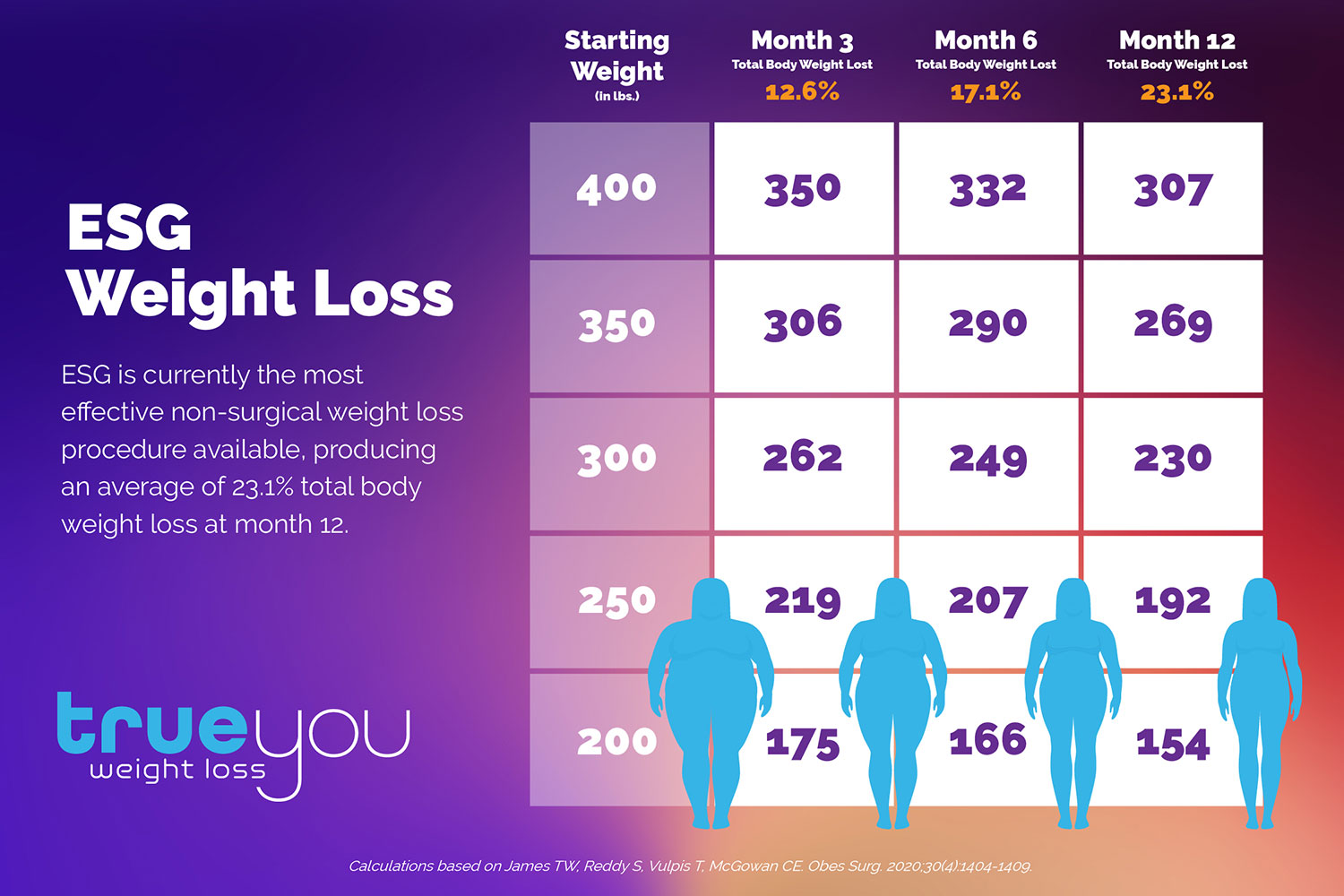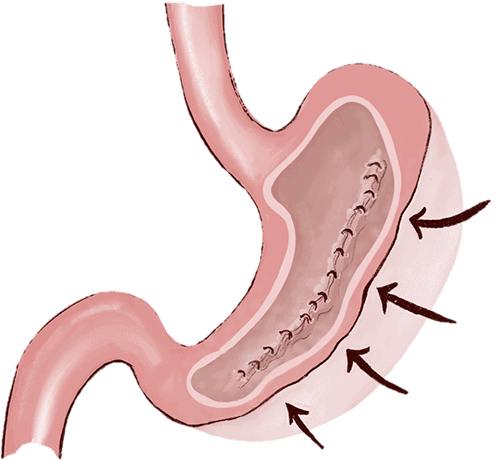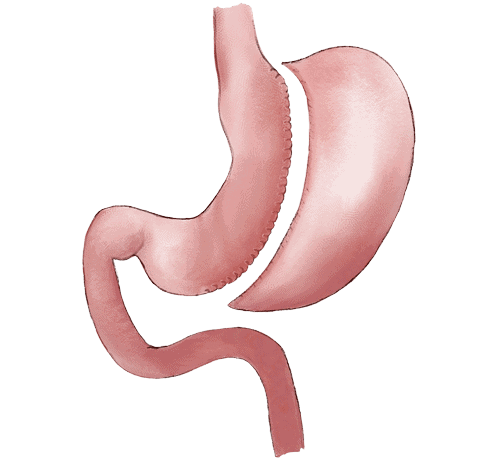Endoscopic sleeve gastroplasty (also known as ESG) is an innovative, non-surgical weight loss procedure that can help you lose up to 20% of your body weight. It’s a safe and highly-effective option that rivals traditional bariatric surgery – offering comparable weight loss results without surgery. The endoscopic sleeve gastroplasty procedure reduces the size of your stomach by 70% to 80%, which limits how much you can eat, restricts your calorie intake, and helps you feel full for longer – all resulting in rapid, sustainable weight loss.
The ESG procedure is performed by expert physicians who are highly-trained in gastroenterology and obesity medicine. Using a revolutionary suturing device that enters the body through the mouth, your doctor will place stitches inside the stomach to reduce its size – all without any external incisions or cutting. It differs significantly from bariatric surgery in that it’s non-surgical, requires minimal downtime, and carries an extremely low risk of complications. For patients who have tried diet and exercise for decades without success, endoscopic sleeve gastroplasty offers a new way to reach your weight loss goals quickly, under the direction of an expert medical team – for long-term results.
The True You Weight Loss team has performed more ESG procedures than any other weight loss center in the country – helping thousands of patients lose weight and keep it off. Our personalized approach involves supporting you through every step of your weight loss journey. Our caring and compassionate medical and nutrition team will not only help you through your procedural journey, we get to know you on a personal level – understanding your unique challenges, goals and motivations. This helps us develop a plan for long-term weight loss success that is tailored to your specific needs.
You might be a candidate for ESG if you:
The FDA has authorized endoscopic sleeve gastroplasty for men and women aged 21 and over. During your consultation, your True You Weight Loss team will learn more about your personal history, including previous weight loss efforts, medical conditions, and current medications to determine whether the endoscopic sleeve gastroplasty might be the right procedure for you.
At True You Weight Loss, our highly-experienced team is committed to your success – and that begins long before the day of your procedure.
Before your ESG, your physician may request certain lab tests and will provide detailed instructions for you to follow before your procedure. You will need to fast before your procedure, and you may need to make temporary changes to some of your medications before and after treatment.
ESG is performed under sedation, which means you will be asleep throughout the procedure – which takes less than 60 minutes to complete.
Your physician will use an endoscope to perform your procedure, which is placed in the mouth and down into the stomach. The endoscope is a flexible tube with a camera on the end so your doctor can “see” the treatment area. The endoscope is equipped with a suturing system, which places stitches in the stomach to reduce its size.
ESG changes the shape of the stomach to a tube or sleeve, reducing your stomach’s capacity by approximately 70-80%. The sutures will remain in your body, which allows your stomach tissue to heal around the new shape. Recovery time is minimal, with most patients returning to work and/or regular activities after just two to three days.
ESG is the most effective non-surgical weight loss procedure available today. When combined with a healthy lifestyle, patients lose an average of 20% of total body weight at the one-year mark. Although results can vary for each individual, most of our patients lose 70% or more of their excess weight. Recent data proves that most patients maintain that weight loss for more than two years and typically up to 5 years or more.
Weight loss isn’t the only benefit you will see after endoscopic sleeve gastroplasty. Other benefits include:
Long-term commitment to our program is the single greatest contributor to your success. Maintaining follow-up appointments with your care team, meeting with your dietitian regularly, and incorporating a healthy lifestyle will help you achieve your goals. And, your True You Weight Loss team will be here to support you every step of the way!

Surgical sleeve gastrectomy is an invasive procedure that involves removing a portion of the stomach. See how this surgery stacks up against the nonsurgical alternative, ESG:


Bariatric endoscopy is a highly-specialized field of medicine that requires skill, precision, and extensive experience. Endoscopic sleeve gastroplasty is a complex and highly-technical procedure – requiring years of advanced training and education. The best doctor for this type of procedure is a gastroenterologist, not a general surgeon. Gastroenterologists use endoscopic tools every day and undergo specialty training, giving them the experience and expertise to handle a procedure as technically challenging as ESG.
The benefits of choosing True You for your ESG include:
Complex procedures like ESG require a comprehensive skill set to perform successfully. Dr. Lauren Donnangelo, Dr. Daniel Maselli, and Dr. Christopher McGowan are among the few physicians in the nation who are triple board-certified in internal medicine, gastroenterology, and obesity medicine. They are recognized leaders in the field of endoscopic weight loss, having performed thousands of bariatric endoscopy procedures. Because of this expertise, they are routinely called upon to train and educate other physicians in the technique of endoscopic suturing. True You Weight Loss is the highest-volume endoscopic weight loss center in the United States – which means we’ve performed more procedures than any other practice in the country. This unrivaled level of experience translates to better outcomes, greater weight loss, and long-term success for our patients.
At True You Weight Loss, your procedure day is just the beginning of your journey – and we firmly believe that your follow-up care is just as important as the procedure itself. That’s why we provide a comprehensive team of experts to help you achieve your goals by offering individualized guidance for as long as you need it. We offer motivation, encouragement, and support through every step of your journey – helping you to overcome any obstacles and celebrating all your victories – on and off the scale.
No matter where you live, you will receive the highest level of concierge care and service from your True You Weight Loss team. All patients are provided with 24/7 direct access to their physician via their personal cell phone, email, and video chat. We have cared for patients from more than 45 states and 10 countries, offering a highly personalized level of care, attention, and support.
Many of our patients simply don’t want surgery. At the same time, they feel hopeless because the lifestyle modifications of diet and exercise simply aren’t effective. True You provides solutions when you feel as though you’re out of options. While the endoscopic sleeve gastroplasty procedure is not covered by insurance, we offer several financing options.
Patients have traveled to True You from more than 45 states and 10 countries. Our locations are near international airports for ease of travel and we have made arrangements with several local hotels for your convenience. Please note that all patients must be accompanied by a responsible adult when traveling from out of state.
The key difference is that endoscopic sleeve gastroplasty is non-surgical. There are no incisions. It is performed entirely through the mouth using an endoscopic suturing system (Endomina). This allows for a fast recovery and healing, as well as a lower rate of adverse effects. The procedure is done on a same-day, outpatient basis. While ESG reduces the size of the stomach to a similar degree as a surgical sleeve gastrectomy, it does not involve the removal of any portion of the stomach.
The aim of endoscopic sleeve gastroplasty is the same as that of surgical gastric sleeve, that is, to reduce the stomach size by 60-70%. However, ESG has some potential benefits over surgical sleeve gastrectomy:
1. ESG is safer: Sleeve gastrectomy involves cutting the stomach and stapling the ends (hence the name sleeve gastrectomy, -ectomy means removal). This can give rise to serious complications such as bleeding and leaks along the staple line. In ESG, the stomach is sutured from the inside and is not cut. Thus, the risk of major complications is very low.
2. ESG is minimally invasive: With sleeve gastrectomy, a surgeon has to make multiple cuts on the abdominal wall to access the stomach. These later become scars. ESG is an endoscopic procedure; no external cuts or incisions are needed.
3. ESG is an outpatient procedure: ESG does not require hospitalization. It can be done in an outpatient clinic and you can go home the same day. With laparoscopic or surgical gastrectomy, you would need to spend at least a day or two in the hospital.
4. ESG enables faster recovery: As ESG requires no cutting of the abdominal muscles, the recovery is fast, and you can return to work and your daily chores within 2-3 days post-procedure. With sleeve gastrectomy, you might need to rest for more than 2-3 weeks.
Learn more about the differences between ESG and sleeve gastrectomy.
Yes! In July 2022, the Apollo ESG received FDA authorization for the treatment of adults with a body mass index (BMI) between 30 kg/m2 and 50 kg/m2. Previously, the FDA approved the Apollo Overstitch endoscopic suturing system for the non-specific indication of “tissue apposition.” But now the specific ESG procedure is FDA-authorized, based on the proven safety and efficacy results from clinical studies.
At True You, we believe the cost of endoscopic sleeve gastroplasty should be transparent and all-inclusive so you know exactly how much you will pay. The True You ESG features a set price of $11,995, which includes services like your initial consultation and labs, 24/7 direct physician access, unlimited medical follow-up, and one full year of one-on-one nutrition counseling.
Since ESG is not covered by insurance at this time, we also provide several financing options to help make your weight loss treatment affordable for you.
Approximately 30-40 minutes. The procedure is performed under anesthesia in an endoscopy suite. You will recover for 1-2 hours after the procedure. You will then be discharged home.
We recommend taking 2-3 days off after the procedure, to rest and recover.
Once the stomach heals, it should remain in a smaller size and shape long-term. U.S. studies tell us that weight loss after endoscopic sleeve gastroplasty is maintained for up to 5 years. The key to sustaining weight loss is to adhere to the recommended diet and to maintain a regular exercise regimen. We advise that overeating can lead to weight regain and/or failure of the sleeve over time, as with any weight loss procedure.
Yes. There are no specific lifting restrictions immediately after ESG. However, we recommend starting first with light walking, even as soon as the day of your procedure. This helps with the recovery and passage of gas. Once you are meeting your protein and fluid goals consistently, you can begin to exercise more intensely. We generally recommend avoiding very strenuous exercise for 3-4 weeks, as your caloric intake may be too low to support this at first (you may get tired). After the first month, you should be able to do any form of exercise without limitation.
After you have healed and recovered from your procedure, it is safe to become pregnant, though we generally recommend waiting a minimum of 6 months before trying to get pregnant. We advise patients that fertility may increase after ESG, due to the metabolic improvements associated with weight loss.
We will closely monitor your progress following the ESG procedure, to ensure that your weight loss is on track. It is very common and expected to have periods of slower weight loss during the 12-month process. If, despite optimizing your diet and exercise, you still need further assistance, we may recommend weight loss medications (pharmacotherapy). This would be provided under the guidance of your treating physician. These medications can greatly enhance your weight loss when used in conjunction with the ESG procedure.
Yes. If the initial procedure is not completely successful, it can be safely repeated or tightened.